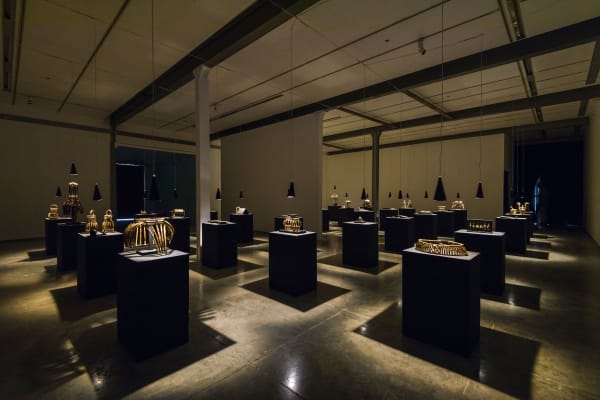Juloos and Other Stories: Shakuntala Kulkarni
"Juloos and Other Stories" is a multimedia project consisting of four synchronized videos, chalk drawings on board, prints of wiped-off chalk drawings and cane accessories.
The film Juloos is a declaration of the vision that each and every person has equal rights and freedom as an individual, and, as part of a community. Within the space of this declaration Shakuntala Kulkarni has addressed her concern, the violation of the female body, in public and private spaces. She has dived into memories, archives and histories, taking references from the terracotta warriors of China. As they march, stand or sit, holding spears or swords – visible in their invisibility. As individuals these warriors (the artist posturing in multiple images) speak of power, grace and valor, standing together in strength and unstoppable and fearless, they join the Julus, declaring the future they have created for themselves and the community; a future of freedom and equality.
Kulkarni’s relationship with the chalk boards, traces back to more than two decades. Initially, the drawings were forms of communication with the craftsman working on Kulkarni’s cane armours, and gradually the context and the manner of drawing shifted. These boards were diaristic, filled with sketches, scribbles, drawings with charcoal, pencil, paint, rubbings, with further layers of paint to make place for more scribbles and drawings. In the process, some of the colour, drawings, tape marks, remained as stains or markings in the background, with each layer creating a new surface.
The drawings were not planned or structured, nor was their scale or placement. The flexibility and playfulness of the material, and the act of wiping interested her, and she continued to do chalk drawings on board. When the board was full, the drawings were documented and then wiped out.
In this exhibition, "Juloos and Other Stories", the film addresses performance, which is planned and structured with a beginning and an end, and the chalk drawings address performativity: an experience of timelessness, and a process. The drawings become free in spirit. They became a visual utterance by which the female protagonists perform a particular act, an act of adorning. Through the drawings, there is now a shaping and scripting of who these protagonists are, with respect to their bodies and action.






